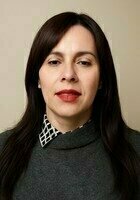All Finite Mathematics Resources
Example Questions
Example Question #3 : Probability
Two fair dices are rolled. If the first die is an odd number what is the probability that the sum of the two dice equal 8?
First, recall that each die is rolled independently.
Now, it is known that the first die is an odd number therefore the possible options are:
From here, find the number of combinations each one will have to make a sum of 8 with the other die.
By investigation, die number one cannot be one because it along with any value from die two will not equal eight.
Therefore, investigate when die one is three.
Next, if die one is five then the possible sum is,
Therefore there are a total of two possibilities of rolling a sum equaled to eight.
From here, identify the total number of options the sum could be when it does not equal eight.
Example Question #4 : Probability
A coin is loaded so that it comes up heads 60% of the time. If it is tossed six times, what is the probability that it will come up heads at least five times?
Choose the closest response.
Since each trial can have one of two outcomes, heads or tails, this is an example of a Bernoulli process.
The probability that 


where 

Since there are six tosses, set 




Since we are looking for the probability of heads coming up at least five times, evaluate 
Of the five choices, 0.25 comes closest.
Example Question #1 : Independence
Jan and Jeff are playing a game of poker dice, in which a turn comprises the following process:
1) Roll all five dice - note: these are standard six-sided dice, which you may assume to be fair.
2) Keep the dice you want, then roll the remaining dice in hope of improving your score.
3) Repeat Step 2, after which whatever you have stands.
Jan is down to her last turn. She has rolled the dice once and has the following: 1-2-3-4-6.
She must score a "large straight", which comprises five dice in sequence. (1-2-3-4-5, or 2-3-4-5-6). If she re-rolls the "6", what is the probability that she will get her large straight on her second or third roll?
Let 
The easiest way to find the probability that Jan will complete her large straight - by rolling a "5" - is to find the probability that she will not complete it. This happens if she rolls any number other than "5" on both rolls, which, by the multiplication principle, will happen with probability
The probability that she will get the straight is this probability subtracted from 1, or
Example Question #1 : Independence
A penny is flipped ten times; each flip results in heads.
True or false: The coin must be loaded so that it comes up heads more often than tails.
True
False
False
Suppose the coin is indeed fair. The probability of the coin coming up heads in one trial is 

Example Question #2 : Independence
Mike and Spike are playing a game of poker dice, in which a turn comprises the following process:
1) Roll all five dice - note: these are standard six-sided dice, which you may assume to be fair.
2) Keep the dice you want, then roll the remaining dice in hope of improving your score.
3) Repeat Step 2, after which whatever you have stands.
Mike is down to his last turn. He has rolled the dice once and has the following: 1-3-3-3-5.
He must roll a five of a kind in order to score. If he re-rolls the "1" and the "5", what is the probability that he will get five "3's"?
In order for Mike to get his five-of-a-kind, one of three things has to happen:
1) He can roll two "3's" on his next turn. There is only one way out of thirty-six for this to happen, so the probability of rolling two 3's is 
2) He can roll one "3" on his next turn, then one "3" on his third turn. There are ten ways out of thirty-six to roll exactly one "3" with a pair of dice (1-3, 2-3, 4, 3, 5-3, 6-3, 3-1, 3-2, 3-4, 3-5, 3-6), making this probability 


3) He can roll no "3's" on his next turn, then two "3's" on his third turn. There are twenty-five ways out of thirty-six to roll two dice and not get a 3, so the probability of this is 


These three scenarios are mutually exclusive and together comprise the event that Mike gets his two 3's. Add the probabilities:
Example Question #2 : Independence
A number of black and white balls are placed in a box. A ball is drawn and replaced, and its color is noted; this is repeated 100 times. At the end of the experiment, it is noted that a black ball was drawn 23 times; it is concluded that the probability of drawing a black ball from the box is 
This is an example of:
Empirical probability
Theoretical probability
Empirical probability
Empirical probability is based on repeated experimentation and observation; theoretical probability is calculated based on equally probable events and the number of such events favorable to a given outcome.
The probability that a black ball will be drawn is hypothesized based on an experiment, in which the number of times a black ball was drawn compared to the number of total draws was observed. The probability was derived based on this observation. This is therefore an example of empirical probability.
Example Question #3 : Independence
A fair coin comes up heads with probability 
Theoretical probability
Empirical probability
Theoretical probability
Empirical probability is based on repeated experimentation and observation; theoretical probability is calculated based on equally probable events and the number of such events favorable to a given outcome.
The two outcomes for the flip of a fair coin are two, which are equally probable. The probability of each outcome is 
Example Question #4 : Independence
The twelve face cards (kings, queens, jacks) are separated from a standard deck of 52 cards. Two cards are selected at random from the twelve, without replacement. What is the probability that the two cards will be of different color?
Two cards are drawn from the deck without regard to order, so the sample space 
The event 
The probability of the event is

Example Question #4 : Independence
The four aces, the four deuces, and the joker are separated from a standard deck of 53 cards. Two cards are selected at random from the nine, without replacement. What is the probability that both cards will be red?
Note: The joker is considered to be neither red nor black.
Two cards are drawn from the deck without regard to order, so the sample space 
The event 
The probability of the event is
All Finite Mathematics Resources























































